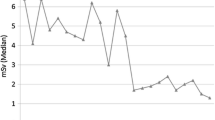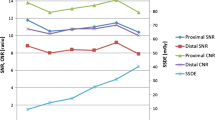Abstract
Background
Recent advances have led to a rapid increase in the number of computed tomography coronary angiography (CTCA) studies performed. Whereas several studies have reported the effective dose, there are no data available on cancer risk for current CTCA protocols.
Methods and Results
Effective and organ doses were estimated, by use of scanner-derived parameters and Monte Carlo methods, for 50 patients having 16-slice CTCA performed for clinical indications. Lifetime attributable risks were estimated with models developed in the National Academies’ Biological Effects of Ionizing Radiation VII report. The effective dose of a complete CTCA averaged 9.5 mSv, whereas that of a complete study, including calcium scoring when indicated, averaged 11.7 mSv. Calcium scoring increased effective dose by 25%, whereas tube current modulation reduced it by 34% and was more effective at lower heart rates. Organ doses to the lungs and female breast were highest. The lifetime attributable risk of cancer incidence from CTCA averaged approximately 1 in 1,600 but varied widely among patients, being highest in younger women. For all patients, the greatest risk was from lung cancer.
Conclusions
CTCA is associated with non-negligible risk of malignancy. Doses can be reduced by careful attention to scanning protocol.
Similar content being viewed by others
References
Raff GL, Gallagher MJ, O'Neill WW, Goldstein JA. Diagnostic accuracy of noninvasive coronary angiography using 64-slice spiral computed tomography. J Am Coll Cardiol 2005;46:552–7.
Mollet NR, Cademartiri F, van Mieghem CA, Runza G, McFadden EP, Baks T, et al. High-resolution spiral computed tomography coronary angiography in patients referred for diagnostic conventional coronary angiography. Circulation 2005;112:2318–23.
Task Group on Control of Radiation Dose in Computed Tomography. Managing patient dose in computed tomography. A report of the International Commission on Radiological Protection. Ann ICRP 2000;30(4):7–45.
Wiest PW, Locken JA, Heintz PH, Mettler FA Jr. CT scanning: a major source of radiation exposure. Semin Ultrasound CT MR 2002;23:402–10.
Einstein AJ, Moser KW, Thompson RC, Cerqueira MD, Henzlova MJ. Radiation dose to patients from cardiac diagnostic imaging. Circulation 2007;116:1290–305.
Coles DR, Smail MA, Negus IS, Wilde P, Oberhoff M, Karsch KR, et al. Comparison of radiation doses from multislice computed tomography coronary angiography and conventional diagnostic angiography. J Am Coll Cardiol 2006;47:1840–5.
Hausleiter J, Meyer T, Hadamitzky M, Huber E, Zankl M, Martinoff S, et al. Radiation dose estimates from cardiac multislice computed tomography in daily practice: impact of different scanning protocols on effective dose estimates. Circulation 2006;113: 1305–10.
Hunold P, Vogt FM, Schmermund A, Debatin JF, Kerkhoff G, Budde T, et al. Radiation exposure during cardiac CT: effective doses at multi-detector row CT and electron-beam CT. Radiology 2003;226:145–52.
Trabold T, Buchgeister M, Küttner A, Heuschmid M, Kopp AF, Schröder S, et al. Estimation of radiation exposure in 16-detector row computed tomography of the heart with retrospective ECG-gating. Rofo 2003;175:1051–5.
Sanz J, Rius T, Kuschnir P, Fuster V, Goldberg J, Ye XY, et al. The importance of end-systole for optimal reconstruction protocol of coronary angiography with 16-slice multidetector computed tomography. Invest Radiol 2005;40:155–63.
Morin RL, Gerber TC, McCollough CH, Wilde P, Oberhoff M, Karsch KR. Radiation dose in computed tomography of the heart. Circulation 2003;107:917–22.
Zanzonico P, Rothenberg LN, Strauss W. Radiation exposure of computed tomography and direct intracoronary angiography: risk has its reward. J Am Coll Cardiol 2006;47:1846–9.
Bongartz G, Golding SJ, Jurik AG, Leonardi M, van Persijn van Meerten E, Rodríguez R, et al. European guidelines for multislice computed tomography, 2004. Available from: URL: http://www.msct.eu/CT_Quality_Criteria.htm. Accessed February 19, 2008.
Bongartz G, Golding SJ, Jurik AG, Leonardi M, van Persijn van Meerten E, Geleijns J, et al. European guidelines on quality criteria for computed tomography: EUR 16262. 2000. Available from: URL: http://www.drs.dk/guidelines/ct/quality/. Accessed August 24, 2007.
Kalender WA, Schmidt B, Zankl M, Schmidt M. A PC program for estimating organ dose and effective dose values in computed tomography. Eur Radiol 1999;9:555–62.
1990 Recommendations of the International Commission on Radiological Protection. Ann ICRP 1991;21(1–3):1–201.
Committee to Assess Health Risks from Exposure to Low Levels of Ionizing Radiation. National Research Council of the National Academies. Health risks from exposure to low levels of ionizing radiation: BEIR VII Phase 2. Washington, DC: The National Academies Press; 2006.
Upton AC, National Council on Radiation Protection and Measurements Scientific Committee 1–6. The state of the art in the 1990’s: NCRP Report No. 136 on the scientific bases for linearity in the dose-response relationship for ionizing radiation. Health Phys 2003;85:15–22.
Brenner DJ, Doll R, Goodhead DT, Hall EJ, Land CE, Little JB, et al. Cancer risks attributable to low doses of ionizing radiation: assessing what we really know. Proc Natl Acad Sci U S A 2003;100:13761–6.
Jakobs TF, Becker CR, Ohnesorge B, Flohr T, Suess C, Schoepf UJ, et al. Multislice helical CT of the heart with retrospective ECG gating: reduction of radiation exposure by ECG-controlled tube current modulation. Eur Radiol 2002;12:1081–6.
Abada HT, Larchez C, Daoud B, Sigal-Cinqualbre A, Paul JF. MDCT of the coronary arteries: feasibility of low-dose CT with ECG-pulsed tube current modulation to reduce radiation dose. AJR Am J Roentgenol 2006;186:S387–90.
Hur G, Hong SW, Kim SY, Kim YH, Hwang YJ, Lee WR, et al. Uniform image quality achieved by tube current modulation using SD of attenuation in coronary CT angiography. Am J Roentgenol 2007;189:188–96.
Low-dose extrapolation of radiation-related cancer risk. Ann ICRP 2005;35:1–140.
Upton AC, Adelstein SJ, Brenner DJ, Clifton KH, Finch SC, Hall EJ, et al. Report no. 136—evaluation of the linear-nonthreshold dose-response model for ionizing radiation. Bethesda (MD): National Council on Radiation Protection & Measurements; 2001.
Sources and effects of ionizing radiation. United Nations Scientific Committee on the Effects of Atomic Radiation UNSCEAR 2000 report to the General Assembly, with scientific annexes. New York: United Nations; 2000.
Cox R, Muirhead CR, Stather JW, Edwards AA, Little MP. Risk of radiation-induced cancer at low doses and low dose rates for radiation protection purposes. Documents of the NRPB. 1995;6:1–77.
Tubiana M, Aurengo A, Masse R, Valleron AJ. Risk of cancer from diagnostic X-rays. Lancet 2004;363:1908, author reply 1910.
Health Physics Society. Radiation risk in perspective: position statement of the health physics society. Adopted January 1996. Revised August 2004. Available from: URL: http://hps.org/documents/radiationrisk.pdf. Accessed August 24, 2007.
Berrington de Gonzalez A, Darby S. Risk of cancer from diagnostic X-rays: estimates for the UK and 14 other countries. Lancet 2004;363:345–51.
Althen JN. Automatic tube-current modulation in CT—a comparison between different solutions. Radiat Prot Dosimetry 2005;114: 308–12.
Einstein AJ, Henzlova MJ, Rajagopalan S. Estimating risk of cancer associated with radiation exposure from 64-slice computed tomography coronary angiography. JAMA 2007;298:317–23.
Author information
Authors and Affiliations
Corresponding author
Additional information
This study was presented in part at the American College of Cardiology 55th Annual Scientific Session, Atlanta, Ga, March 13, 2006.
This work was supported in part by a National Institutes of Health/National Center for Research Resources Clinical and Translational Science Award (1 UL1 RR-24156-01).
Rights and permissions
About this article
Cite this article
Einstein, A.J., Sanz, J., Dellegrottaglie, S. et al. Radiation dose and cancer risk estimates in 16-slice computed tomography coronary angiography. J Nucl Cardiol 15, 232–240 (2008). https://doi.org/10.1016/j.nuclcard.2007.09.028
Received:
Accepted:
Issue Date:
DOI: https://doi.org/10.1016/j.nuclcard.2007.09.028




